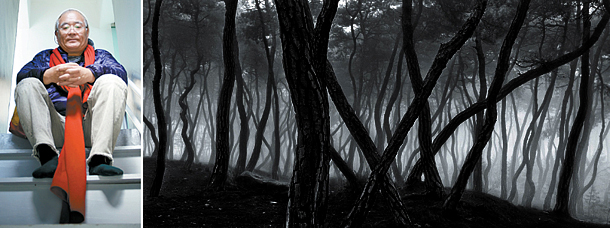A poetic touch to photography : Bae Bien-u’s pine tree pictures resemble East Asian ink paintings

Bae Bien-u, left, one of the most famous Korean photographers in the world, gained fame with his black-and-white photographs of pine trees, right. He was invited by the Corea Image Communication Institute to be the chairman of a jury for the institution’s “Korea Through the Lens” contest in which Koreans and foreigners residing in Korea submitted photo and video works that best represent the country. The Korea JoongAng Daily sat with Bae on Tuesday to talk about the contest and the photographer’s aesthetics. [JOONGANG SUNDAY, BAE BIEN-U]
So, it is no surprise that he was invited by the Corea Image Communication Institute to chair a jury for the organization’s “Korea Through the Lens” contest in which Koreans and foreigners residing in the country submitted photo and video works that best represent the country. The top prize went to calligrapher Kang Byung-in and photographer Lim Chae-wook for co-creating a video piece titled “Beautiful Korea and Hangul.”
The Korea JoongAng Daily sat with Bae on Tuesday at the Grand Hyatt hotel in central Seoul to talk about the contest and the photographer’s aesthetics. The following are excerpts of the interview.
Q.What was your impression of the “Korea Through the Lens” entries?
A. While examining the entries, I came to feel that video pieces are more interesting than still photos, even though I’m a photographer myself. A good photograph requires long-term training, as it should tell a story with only one image. On the other hand, a good video piece needs a good story or good images - not necessarily both.
I like the winning video piece’s unique attempt to animate hangul calligraphy. If it were Chinese characters, which are ideograms that originate from pictograms, it would not be surprising, but hangul letters are phonograms, so it was a difficult attempt. But, it ended in success. The video piece is also in the East Asian tradition of muninhwa [scholars’ ink paintings], in which poetry, calligraphy and painting are combined.
People say your photographs of pine trees are a modern version of muninhwa, like the famous painting “Sehando” by the scholar-calligrapher Kim Jeong-hui. What do you think?
Of course, my works are related to muninhwa. But my works, photographs, can’t help being different from typical muninhwa, most of which are conceptual landscape paintings. Even “Sehando” is different from them. You know the pine tree in the painting has a curved and tilted trunk with a branch that is curved downward. It is an exact depiction of a pine tree found in Jeju Island. [Kim painted it when he was living in exile in the island.] The pine trees in the island have curved but solid trunks as they grow fighting against the heavy winds from the sea. So it is different from conceptual muninhwa.
Then, have you also taken pictures of pine trees in Jeju Island?
Yes, but nearly 90 percent of my photographs of pine trees exhibited to the public are those of trees in Gyeongju, North Gyeongsang. Their trunks and branches are less curved than those in Jeju but not as straight as those of pine trees in inland areas without much wind. Our ancestors loved pine trees and planted them around houses and tombs. Gyeongju [which was the capital of the ancient kingdom Silla (B.C. 57-A.D. 935)] has many fine pine trees as it is home to many old tombs of the Silla dynasty. The pine trees around tombs were believed to protect the souls of the dead and help them communicate with the heavens.
Some painters, such as the renowned David Hockney, say paintings by hand can better express what humans perceive through their bodies than photography. What do you think?
That’s not entirely wrong. But I don’t think painting and photography are that separate from each other. Most major inventors in the history of photography were painters. What is important is which mind you take a photograph with.
If you take pictures with a journalist’s mind, the outcome will be photojournalism. If you take photos with an artist’s mind, it will be photo art. When I presented my works at The House for Mozart at the Salzburg Festival in Austria, I told the audience I’m a photo-painter. Then, a graduate school student said, “No, you are a photo-poet.” Photography is like that.
How many prints do you make of each photograph?
It is my habit to make up to five prints of the same size for each photograph. But the number of prints for museum collections can be adjusted at the request of the museum. People might think it is easy to make a photographic print but actually it takes more than two months to make each one.
BY MOON SO-YOUNG [symoon@joongang.co.kr]










with the Korea JoongAng Daily
To write comments, please log in to one of the accounts.
Standards Board Policy (0/250자)